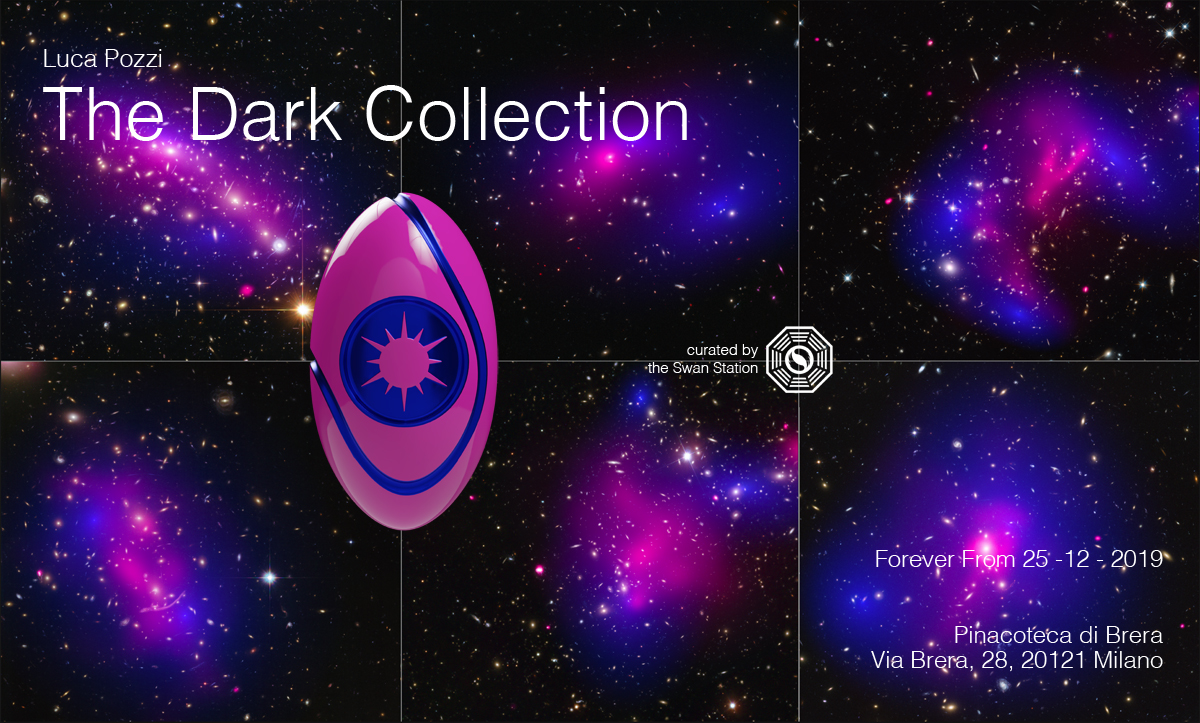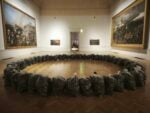Luca Pozzi – The Dark Collection

Il primo progetto in realtà aumentata di Luca Pozzi in mostra permanente.
Comunicato stampa
On December 24th at midnight an Android application for smartphones will be released, downloadable directly from the artist's website*. Called the "Dark Collection" and installable for free on your device, it will make visible a series of twelve 3D graphics sculptures named “Third Eye Prophecy”, within the spaces of the Pinacoteca di Brera's collection in Milan, effectively constituting an alternative exhibition.
A great collection that combines the early experiments of Gothic art of the 13th century with futurist and metaphysical artworks of the 1900s, passing through the Italian Renaissance masterpieces by Bellini, Mantegna, Tintoretto, Veronese up to Caravaggio, and that, starting from December 25th, it will grow by a parallel immaterial dark collection, donated by the Milanese to his hometown.
Used to museum raids, after the jumps in front of the Veronese's paintings at the Louvre in Paris, the Sabauda Gallery in Turin, the Chateaux Versailles and the Gallerie dell'Accademia in Venice, Pozzi returns to the Pinacoteca di Brera where the pilgrimage began in 2007 to find alternative connections and experiment with new technologies. Unhinging the temporal linearity and reversing the point of view, this time he focuses on the voids, on the distances and on the relationships between the paintings to give voice to a hidden dimension, normally considered insignificant and negligible.
Inspired by the relational approach of Twistor Theory by physicist Roger Penrose from 1967 and always interested in scientific research in the field of quantum gravity and multi-messenger cosmology, with "The Dark Collection" Luca Pozzi triggers a visual counterpart of dark matter, currently studied at the Gran Sasso National Laboratories and visited by the artist in June 2018 in collaboration with the INFN (National Institute of Nuclear Physics).
An elusive matter that unlike anything we have direct experience with, does not interact with the electromagnetic field and can only be observed indirectly through purely gravitational effects.
In this sense, the space that separates the artworks and the peripheral areas of the paintings themselves become an opportunity to bring out a previously invisible bond, a pattern that will remain active as long as the historical collection will be rearranged.
The relationship of distance between one frame and another, the back wall, the "between" the works become specific formal related characteristics which, thanks to the technology of the target image AR implemented in "The Dark Collection", become an unexpected new protagonist.
This is how, for example, between Bramante's "Christ at the Column" (1490) and Raphael's "Marriage of the Virgin" (1504), a floating presence will appear on the screens of visitors' smartphones, the color of which derives from the union of the palette of both masterpieces. A kind of contemporary oracle, a third eye wide open on the invisibility of quantum gravity processes.
A series of intangible sculptures that do not exist a priori, but that will emerge everywhere and in every time thanks to the perspective alignment of the spectators who, becoming real detectors, connect distant realities and access a multi-dimensional network of pure information.
*(http://www.lucapozzi.com/project/the-dark-collection/).
Luca Pozzi, (Milan, 1983) is a visual artist and interdisciplinary mediator.
Inspired by the worlds of art, physics, multi-messenger cosmology and computer science, after graduating with a degree in painting and specializing in computer graphics and systems, he collaborates with visionary scientific communities, including Loop Quantum Gravity (PI), Compact Muon Solenoid (CERN) and the Fermi Large Area Telescope (INFN, NASA).
Studying quantum gravity, teleportation, time travel, cosmology and particle physics, the theoretical research is converted into a series of hybrid installations characterized by magnetized sculptures, levitating objects, light drawings and performative use of photography based on a strange feeling of frozen time and multidimensionality.
His work has been exhibited in major museums and galleries in Italy and abroad, and his pieces are part of prestigious public and private collections, including the Mart of Rovereto, the MAMbo of Bologna, the MEF of Turin, the Italian Ministry of Foreign Affairs collection “LA FARNESINA” and the Archive of Spatial Aesthetics and Praxis of New York. He is known for his photographic series “Supersymmetric Partners”, documenting real jumps in front of the Renaissance paintings of Paolo Veronese, and for his use of electromagnetic levitation technologies in futuristic installations such as “Schroedinger’s cat through Piero Della Francesca influence “(Museo Marino Marini, 2010), “9 Churches 9 Columns” (Moscow Biennale, 2011) and “The Star Platform” (Marrakech Biennale, 2012). In 2013, he invented the device of light drawing by remotely “Oracle” (DLD, Haus der Kunst, Monaco); In 2015 he presented “The Messengers of Gravity” monograph (MEF, Turin) and two years later he activated the cross-disciplinary “Blazing Quasi-Stellar Object” project at the European Organization for Nuclear Research (CERN, Geneva). In 2017 he attended “Documenta 14” as part of the “Eternal Internet Brotherhood community” (Kassel). Of 2018 is his first immersive installation with VR and AR components “The Grandfather Platform”. He is currently collaborating with the INFN on the integration of particle detectors in his artworks, to expand the sensoriality of the human body towards the new frontiers of quantum computing and artificial intelligence.
The Swan Station is an interdisciplinary curatorial platform designed to promote the emergence of a quantum experience of reality through the language of contemporary art. A connective container without pre-established geographical coordinates, characterized by a marked predisposition to counter-intuitive processes such as entanglement, temporal distortions, and multidimensionality. "The Dark Collection", is the first augmented reality guerrilla-style project by Luca Pozzi in a museum institution.



